Marketing Report: Primark's Consumer Behavior and Strategies
VerifiedAdded on 2019/12/03
|16
|4322
|415
Report
AI Summary
This report provides a comprehensive marketing analysis of Primark, examining various aspects of its business operations. It begins with an introduction to marketing intelligence and its application to Primark, a major retail clothing chain. The report then delves into the consumer purchase decision-making process, breaking it down into key stages. It explores different theories of buyer behavior, highlighting the influence of cultural, social, and personal characteristics on consumer choices. The report further evaluates the relationship between brand loyalty, corporate image, and repeated purchases, analyzing Primark's branding strategies, including brand extension and multi-brand strategies. The report also covers market research techniques, including qualitative, observational, and quantitative methods. Finally, the report discusses the use of secondary data for market research objectives, sources of secondary data, and research limitations, including a research plan for Primark's product demand in the London market.

MARKETING INTELLIGENCE
Paraphrase This Document
Need a fresh take? Get an instant paraphrase of this document with our AI Paraphraser
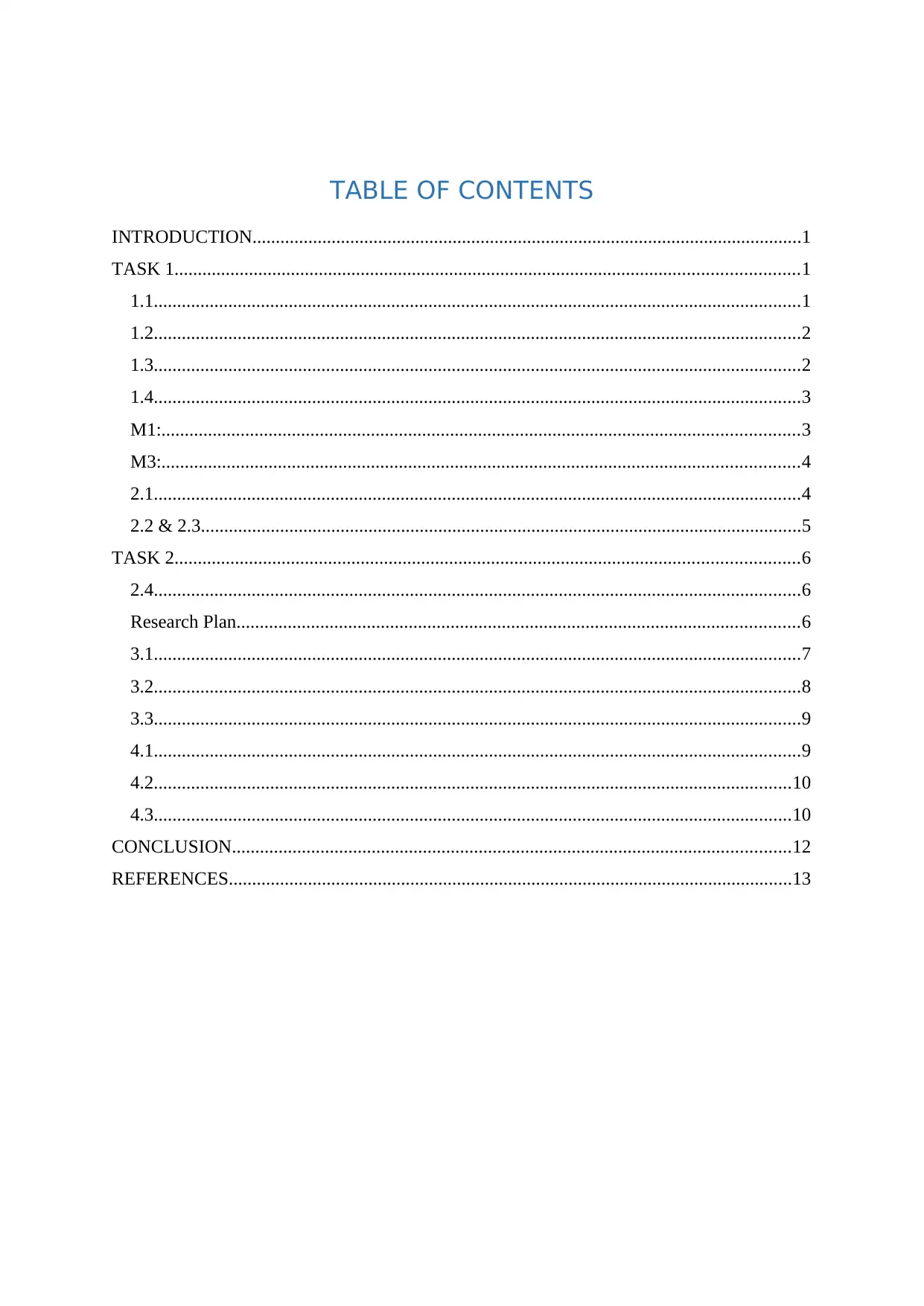
TABLE OF CONTENTS
INTRODUCTION......................................................................................................................1
TASK 1......................................................................................................................................1
1.1...........................................................................................................................................1
1.2...........................................................................................................................................2
1.3...........................................................................................................................................2
1.4...........................................................................................................................................3
M1:.........................................................................................................................................3
M3:.........................................................................................................................................4
2.1...........................................................................................................................................4
2.2 & 2.3.................................................................................................................................5
TASK 2......................................................................................................................................6
2.4...........................................................................................................................................6
Research Plan.........................................................................................................................6
3.1...........................................................................................................................................7
3.2...........................................................................................................................................8
3.3...........................................................................................................................................9
4.1...........................................................................................................................................9
4.2.........................................................................................................................................10
4.3.........................................................................................................................................10
CONCLUSION........................................................................................................................12
REFERENCES.........................................................................................................................13
INTRODUCTION......................................................................................................................1
TASK 1......................................................................................................................................1
1.1...........................................................................................................................................1
1.2...........................................................................................................................................2
1.3...........................................................................................................................................2
1.4...........................................................................................................................................3
M1:.........................................................................................................................................3
M3:.........................................................................................................................................4
2.1...........................................................................................................................................4
2.2 & 2.3.................................................................................................................................5
TASK 2......................................................................................................................................6
2.4...........................................................................................................................................6
Research Plan.........................................................................................................................6
3.1...........................................................................................................................................7
3.2...........................................................................................................................................8
3.3...........................................................................................................................................9
4.1...........................................................................................................................................9
4.2.........................................................................................................................................10
4.3.........................................................................................................................................10
CONCLUSION........................................................................................................................12
REFERENCES.........................................................................................................................13
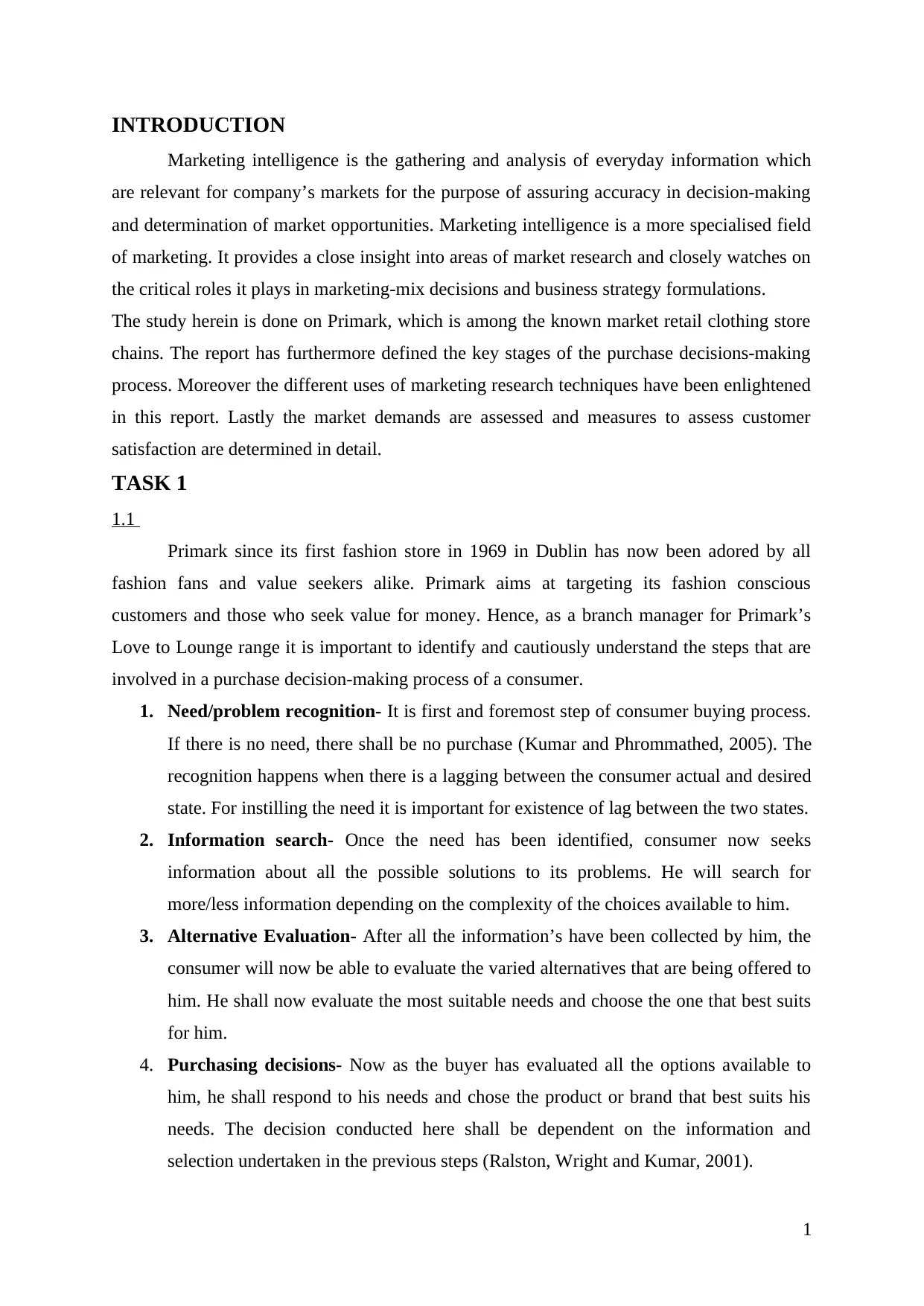
INTRODUCTION
Marketing intelligence is the gathering and analysis of everyday information which
are relevant for company’s markets for the purpose of assuring accuracy in decision-making
and determination of market opportunities. Marketing intelligence is a more specialised field
of marketing. It provides a close insight into areas of market research and closely watches on
the critical roles it plays in marketing-mix decisions and business strategy formulations.
The study herein is done on Primark, which is among the known market retail clothing store
chains. The report has furthermore defined the key stages of the purchase decisions-making
process. Moreover the different uses of marketing research techniques have been enlightened
in this report. Lastly the market demands are assessed and measures to assess customer
satisfaction are determined in detail.
TASK 1
1.1
Primark since its first fashion store in 1969 in Dublin has now been adored by all
fashion fans and value seekers alike. Primark aims at targeting its fashion conscious
customers and those who seek value for money. Hence, as a branch manager for Primark’s
Love to Lounge range it is important to identify and cautiously understand the steps that are
involved in a purchase decision-making process of a consumer.
1. Need/problem recognition- It is first and foremost step of consumer buying process.
If there is no need, there shall be no purchase (Kumar and Phrommathed, 2005). The
recognition happens when there is a lagging between the consumer actual and desired
state. For instilling the need it is important for existence of lag between the two states.
2. Information search- Once the need has been identified, consumer now seeks
information about all the possible solutions to its problems. He will search for
more/less information depending on the complexity of the choices available to him.
3. Alternative Evaluation- After all the information’s have been collected by him, the
consumer will now be able to evaluate the varied alternatives that are being offered to
him. He shall now evaluate the most suitable needs and choose the one that best suits
for him.
4. Purchasing decisions- Now as the buyer has evaluated all the options available to
him, he shall respond to his needs and chose the product or brand that best suits his
needs. The decision conducted here shall be dependent on the information and
selection undertaken in the previous steps (Ralston, Wright and Kumar, 2001).
1
Marketing intelligence is the gathering and analysis of everyday information which
are relevant for company’s markets for the purpose of assuring accuracy in decision-making
and determination of market opportunities. Marketing intelligence is a more specialised field
of marketing. It provides a close insight into areas of market research and closely watches on
the critical roles it plays in marketing-mix decisions and business strategy formulations.
The study herein is done on Primark, which is among the known market retail clothing store
chains. The report has furthermore defined the key stages of the purchase decisions-making
process. Moreover the different uses of marketing research techniques have been enlightened
in this report. Lastly the market demands are assessed and measures to assess customer
satisfaction are determined in detail.
TASK 1
1.1
Primark since its first fashion store in 1969 in Dublin has now been adored by all
fashion fans and value seekers alike. Primark aims at targeting its fashion conscious
customers and those who seek value for money. Hence, as a branch manager for Primark’s
Love to Lounge range it is important to identify and cautiously understand the steps that are
involved in a purchase decision-making process of a consumer.
1. Need/problem recognition- It is first and foremost step of consumer buying process.
If there is no need, there shall be no purchase (Kumar and Phrommathed, 2005). The
recognition happens when there is a lagging between the consumer actual and desired
state. For instilling the need it is important for existence of lag between the two states.
2. Information search- Once the need has been identified, consumer now seeks
information about all the possible solutions to its problems. He will search for
more/less information depending on the complexity of the choices available to him.
3. Alternative Evaluation- After all the information’s have been collected by him, the
consumer will now be able to evaluate the varied alternatives that are being offered to
him. He shall now evaluate the most suitable needs and choose the one that best suits
for him.
4. Purchasing decisions- Now as the buyer has evaluated all the options available to
him, he shall respond to his needs and chose the product or brand that best suits his
needs. The decision conducted here shall be dependent on the information and
selection undertaken in the previous steps (Ralston, Wright and Kumar, 2001).
1
⊘ This is a preview!⊘
Do you want full access?
Subscribe today to unlock all pages.

Trusted by 1+ million students worldwide
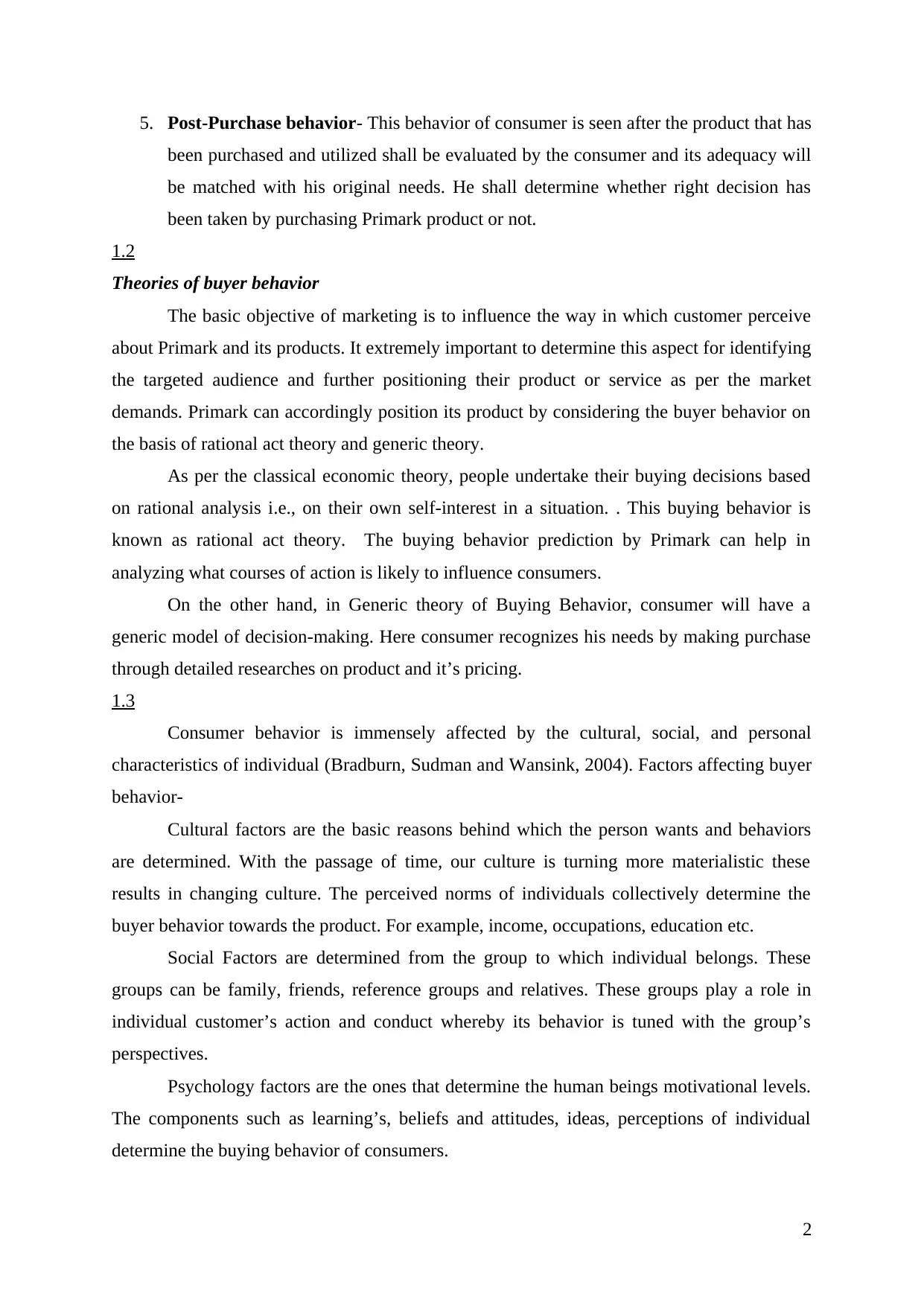
5. Post-Purchase behavior- This behavior of consumer is seen after the product that has
been purchased and utilized shall be evaluated by the consumer and its adequacy will
be matched with his original needs. He shall determine whether right decision has
been taken by purchasing Primark product or not.
1.2
Theories of buyer behavior
The basic objective of marketing is to influence the way in which customer perceive
about Primark and its products. It extremely important to determine this aspect for identifying
the targeted audience and further positioning their product or service as per the market
demands. Primark can accordingly position its product by considering the buyer behavior on
the basis of rational act theory and generic theory.
As per the classical economic theory, people undertake their buying decisions based
on rational analysis i.e., on their own self-interest in a situation. . This buying behavior is
known as rational act theory. The buying behavior prediction by Primark can help in
analyzing what courses of action is likely to influence consumers.
On the other hand, in Generic theory of Buying Behavior, consumer will have a
generic model of decision-making. Here consumer recognizes his needs by making purchase
through detailed researches on product and it’s pricing.
1.3
Consumer behavior is immensely affected by the cultural, social, and personal
characteristics of individual (Bradburn, Sudman and Wansink, 2004). Factors affecting buyer
behavior-
Cultural factors are the basic reasons behind which the person wants and behaviors
are determined. With the passage of time, our culture is turning more materialistic these
results in changing culture. The perceived norms of individuals collectively determine the
buyer behavior towards the product. For example, income, occupations, education etc.
Social Factors are determined from the group to which individual belongs. These
groups can be family, friends, reference groups and relatives. These groups play a role in
individual customer’s action and conduct whereby its behavior is tuned with the group’s
perspectives.
Psychology factors are the ones that determine the human beings motivational levels.
The components such as learning’s, beliefs and attitudes, ideas, perceptions of individual
determine the buying behavior of consumers.
2
been purchased and utilized shall be evaluated by the consumer and its adequacy will
be matched with his original needs. He shall determine whether right decision has
been taken by purchasing Primark product or not.
1.2
Theories of buyer behavior
The basic objective of marketing is to influence the way in which customer perceive
about Primark and its products. It extremely important to determine this aspect for identifying
the targeted audience and further positioning their product or service as per the market
demands. Primark can accordingly position its product by considering the buyer behavior on
the basis of rational act theory and generic theory.
As per the classical economic theory, people undertake their buying decisions based
on rational analysis i.e., on their own self-interest in a situation. . This buying behavior is
known as rational act theory. The buying behavior prediction by Primark can help in
analyzing what courses of action is likely to influence consumers.
On the other hand, in Generic theory of Buying Behavior, consumer will have a
generic model of decision-making. Here consumer recognizes his needs by making purchase
through detailed researches on product and it’s pricing.
1.3
Consumer behavior is immensely affected by the cultural, social, and personal
characteristics of individual (Bradburn, Sudman and Wansink, 2004). Factors affecting buyer
behavior-
Cultural factors are the basic reasons behind which the person wants and behaviors
are determined. With the passage of time, our culture is turning more materialistic these
results in changing culture. The perceived norms of individuals collectively determine the
buyer behavior towards the product. For example, income, occupations, education etc.
Social Factors are determined from the group to which individual belongs. These
groups can be family, friends, reference groups and relatives. These groups play a role in
individual customer’s action and conduct whereby its behavior is tuned with the group’s
perspectives.
Psychology factors are the ones that determine the human beings motivational levels.
The components such as learning’s, beliefs and attitudes, ideas, perceptions of individual
determine the buying behavior of consumers.
2
Paraphrase This Document
Need a fresh take? Get an instant paraphrase of this document with our AI Paraphraser
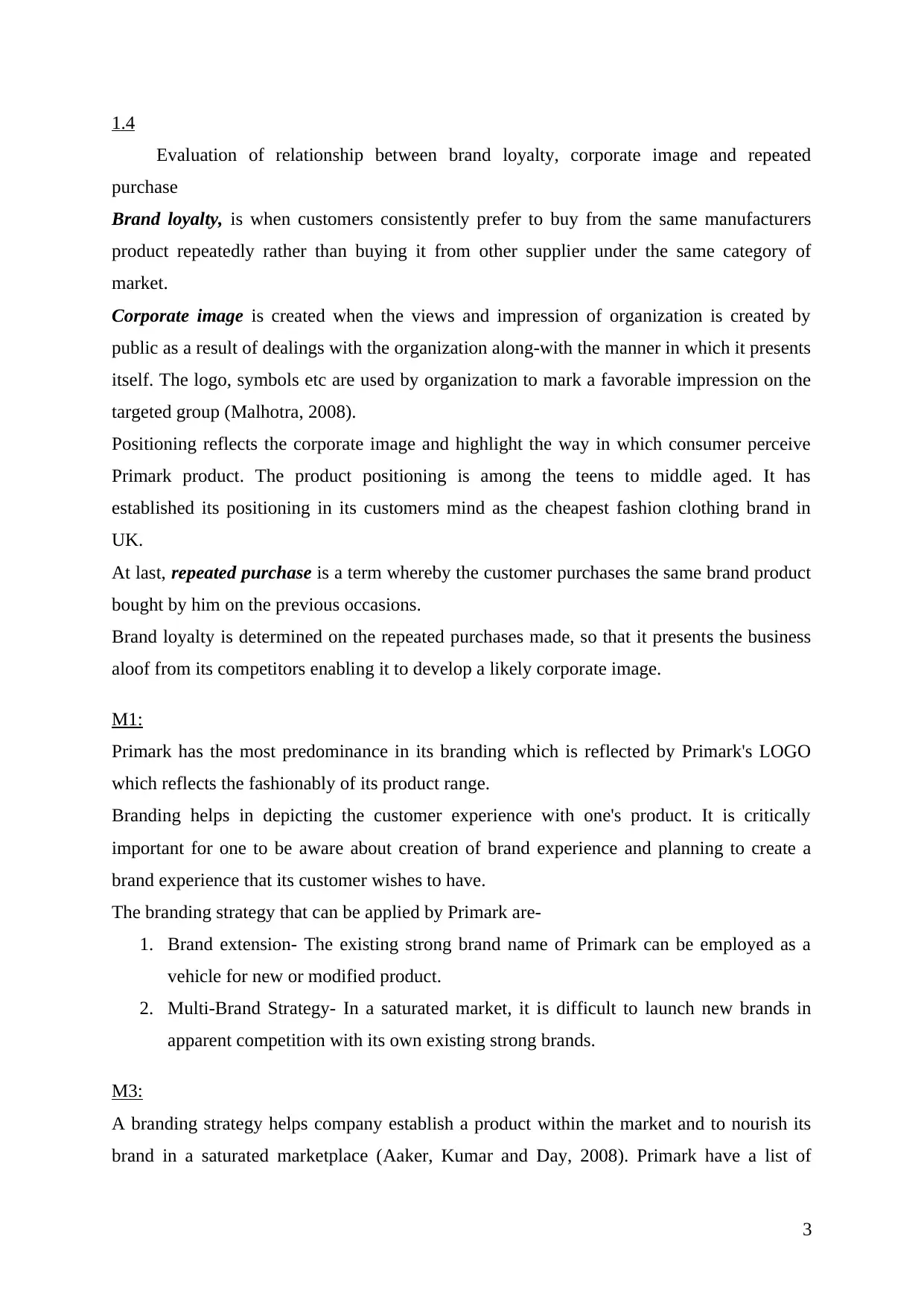
1.4
Evaluation of relationship between brand loyalty, corporate image and repeated
purchase
Brand loyalty, is when customers consistently prefer to buy from the same manufacturers
product repeatedly rather than buying it from other supplier under the same category of
market.
Corporate image is created when the views and impression of organization is created by
public as a result of dealings with the organization along-with the manner in which it presents
itself. The logo, symbols etc are used by organization to mark a favorable impression on the
targeted group (Malhotra, 2008).
Positioning reflects the corporate image and highlight the way in which consumer perceive
Primark product. The product positioning is among the teens to middle aged. It has
established its positioning in its customers mind as the cheapest fashion clothing brand in
UK.
At last, repeated purchase is a term whereby the customer purchases the same brand product
bought by him on the previous occasions.
Brand loyalty is determined on the repeated purchases made, so that it presents the business
aloof from its competitors enabling it to develop a likely corporate image.
M1:
Primark has the most predominance in its branding which is reflected by Primark's LOGO
which reflects the fashionably of its product range.
Branding helps in depicting the customer experience with one's product. It is critically
important for one to be aware about creation of brand experience and planning to create a
brand experience that its customer wishes to have.
The branding strategy that can be applied by Primark are-
1. Brand extension- The existing strong brand name of Primark can be employed as a
vehicle for new or modified product.
2. Multi-Brand Strategy- In a saturated market, it is difficult to launch new brands in
apparent competition with its own existing strong brands.
M3:
A branding strategy helps company establish a product within the market and to nourish its
brand in a saturated marketplace (Aaker, Kumar and Day, 2008). Primark have a list of
3
Evaluation of relationship between brand loyalty, corporate image and repeated
purchase
Brand loyalty, is when customers consistently prefer to buy from the same manufacturers
product repeatedly rather than buying it from other supplier under the same category of
market.
Corporate image is created when the views and impression of organization is created by
public as a result of dealings with the organization along-with the manner in which it presents
itself. The logo, symbols etc are used by organization to mark a favorable impression on the
targeted group (Malhotra, 2008).
Positioning reflects the corporate image and highlight the way in which consumer perceive
Primark product. The product positioning is among the teens to middle aged. It has
established its positioning in its customers mind as the cheapest fashion clothing brand in
UK.
At last, repeated purchase is a term whereby the customer purchases the same brand product
bought by him on the previous occasions.
Brand loyalty is determined on the repeated purchases made, so that it presents the business
aloof from its competitors enabling it to develop a likely corporate image.
M1:
Primark has the most predominance in its branding which is reflected by Primark's LOGO
which reflects the fashionably of its product range.
Branding helps in depicting the customer experience with one's product. It is critically
important for one to be aware about creation of brand experience and planning to create a
brand experience that its customer wishes to have.
The branding strategy that can be applied by Primark are-
1. Brand extension- The existing strong brand name of Primark can be employed as a
vehicle for new or modified product.
2. Multi-Brand Strategy- In a saturated market, it is difficult to launch new brands in
apparent competition with its own existing strong brands.
M3:
A branding strategy helps company establish a product within the market and to nourish its
brand in a saturated marketplace (Aaker, Kumar and Day, 2008). Primark have a list of
3
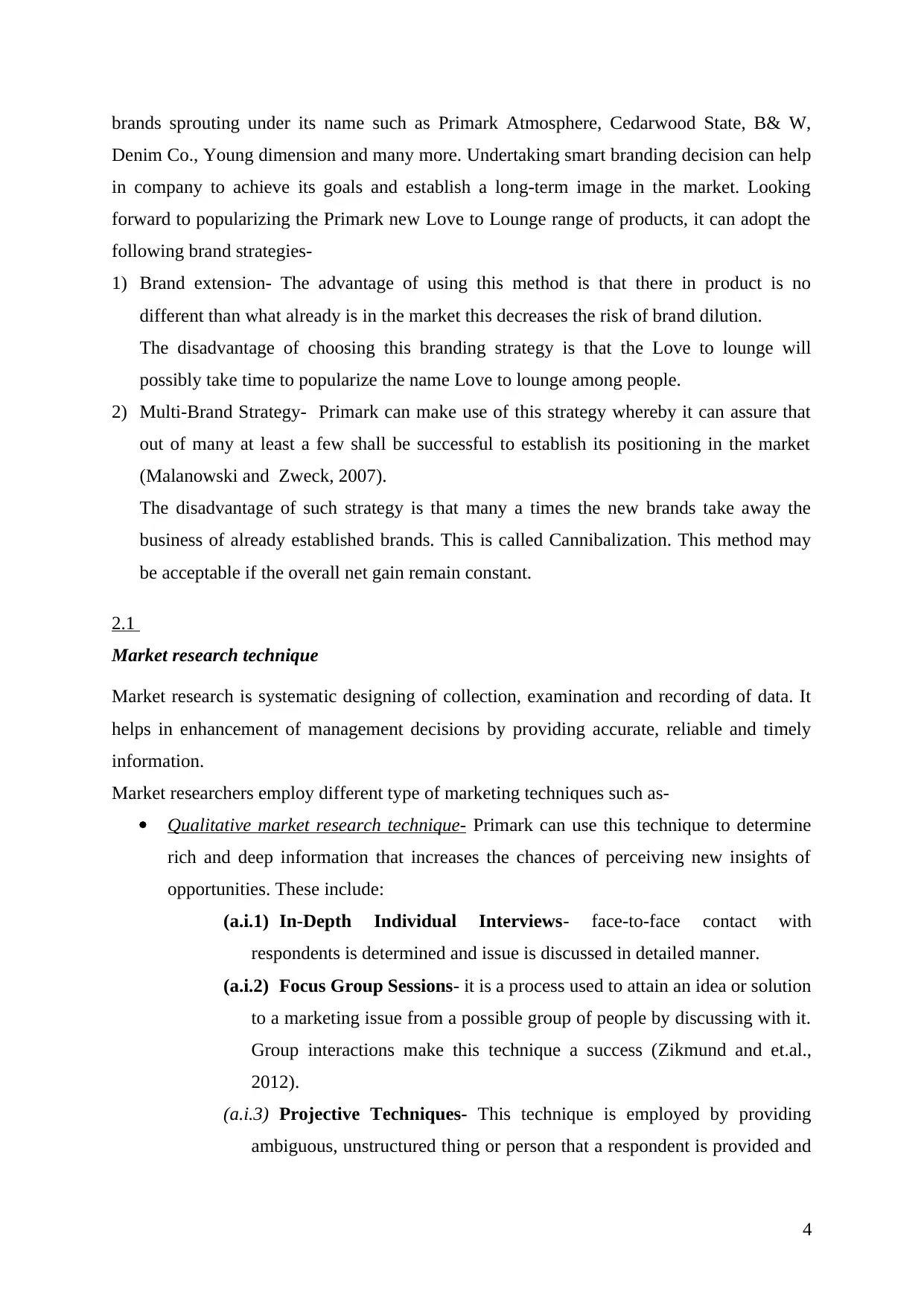
brands sprouting under its name such as Primark Atmosphere, Cedarwood State, B& W,
Denim Co., Young dimension and many more. Undertaking smart branding decision can help
in company to achieve its goals and establish a long-term image in the market. Looking
forward to popularizing the Primark new Love to Lounge range of products, it can adopt the
following brand strategies-
1) Brand extension- The advantage of using this method is that there in product is no
different than what already is in the market this decreases the risk of brand dilution.
The disadvantage of choosing this branding strategy is that the Love to lounge will
possibly take time to popularize the name Love to lounge among people.
2) Multi-Brand Strategy- Primark can make use of this strategy whereby it can assure that
out of many at least a few shall be successful to establish its positioning in the market
(Malanowski and Zweck, 2007).
The disadvantage of such strategy is that many a times the new brands take away the
business of already established brands. This is called Cannibalization. This method may
be acceptable if the overall net gain remain constant.
2.1
Market research technique
Market research is systematic designing of collection, examination and recording of data. It
helps in enhancement of management decisions by providing accurate, reliable and timely
information.
Market researchers employ different type of marketing techniques such as-
Qualitative market research technique- Primark can use this technique to determine
rich and deep information that increases the chances of perceiving new insights of
opportunities. These include:
(a.i.1) In-Depth Individual Interviews- face-to-face contact with
respondents is determined and issue is discussed in detailed manner.
(a.i.2) Focus Group Sessions- it is a process used to attain an idea or solution
to a marketing issue from a possible group of people by discussing with it.
Group interactions make this technique a success (Zikmund and et.al.,
2012).
(a.i.3) Projective Techniques- This technique is employed by providing
ambiguous, unstructured thing or person that a respondent is provided and
4
Denim Co., Young dimension and many more. Undertaking smart branding decision can help
in company to achieve its goals and establish a long-term image in the market. Looking
forward to popularizing the Primark new Love to Lounge range of products, it can adopt the
following brand strategies-
1) Brand extension- The advantage of using this method is that there in product is no
different than what already is in the market this decreases the risk of brand dilution.
The disadvantage of choosing this branding strategy is that the Love to lounge will
possibly take time to popularize the name Love to lounge among people.
2) Multi-Brand Strategy- Primark can make use of this strategy whereby it can assure that
out of many at least a few shall be successful to establish its positioning in the market
(Malanowski and Zweck, 2007).
The disadvantage of such strategy is that many a times the new brands take away the
business of already established brands. This is called Cannibalization. This method may
be acceptable if the overall net gain remain constant.
2.1
Market research technique
Market research is systematic designing of collection, examination and recording of data. It
helps in enhancement of management decisions by providing accurate, reliable and timely
information.
Market researchers employ different type of marketing techniques such as-
Qualitative market research technique- Primark can use this technique to determine
rich and deep information that increases the chances of perceiving new insights of
opportunities. These include:
(a.i.1) In-Depth Individual Interviews- face-to-face contact with
respondents is determined and issue is discussed in detailed manner.
(a.i.2) Focus Group Sessions- it is a process used to attain an idea or solution
to a marketing issue from a possible group of people by discussing with it.
Group interactions make this technique a success (Zikmund and et.al.,
2012).
(a.i.3) Projective Techniques- This technique is employed by providing
ambiguous, unstructured thing or person that a respondent is provided and
4
⊘ This is a preview!⊘
Do you want full access?
Subscribe today to unlock all pages.

Trusted by 1+ million students worldwide
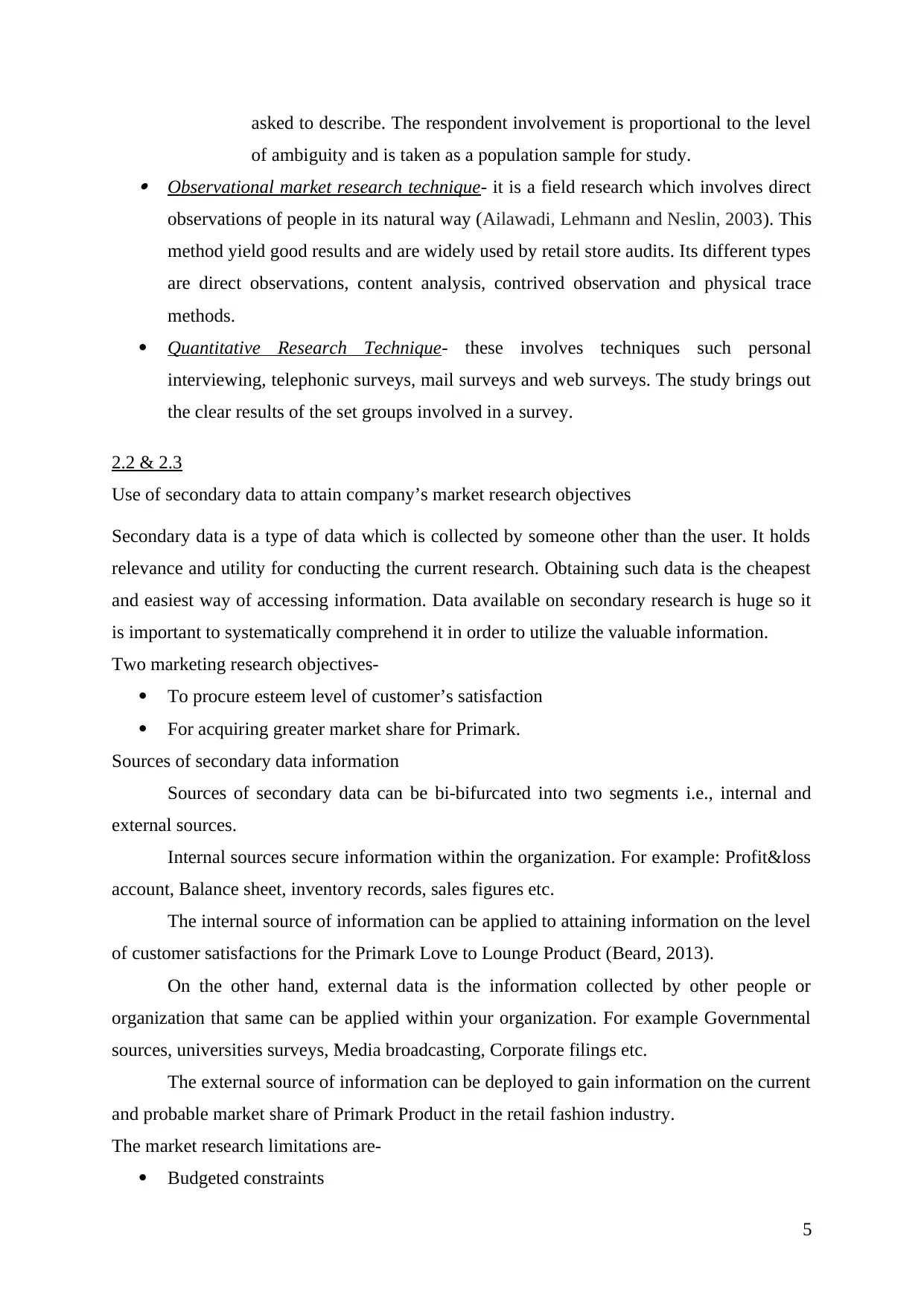
asked to describe. The respondent involvement is proportional to the level
of ambiguity and is taken as a population sample for study. Observational market research technique- it is a field research which involves direct
observations of people in its natural way (Ailawadi, Lehmann and Neslin, 2003). This
method yield good results and are widely used by retail store audits. Its different types
are direct observations, content analysis, contrived observation and physical trace
methods.
Quantitative Research Technique- these involves techniques such personal
interviewing, telephonic surveys, mail surveys and web surveys. The study brings out
the clear results of the set groups involved in a survey.
2.2 & 2.3
Use of secondary data to attain company’s market research objectives
Secondary data is a type of data which is collected by someone other than the user. It holds
relevance and utility for conducting the current research. Obtaining such data is the cheapest
and easiest way of accessing information. Data available on secondary research is huge so it
is important to systematically comprehend it in order to utilize the valuable information.
Two marketing research objectives-
To procure esteem level of customer’s satisfaction
For acquiring greater market share for Primark.
Sources of secondary data information
Sources of secondary data can be bi-bifurcated into two segments i.e., internal and
external sources.
Internal sources secure information within the organization. For example: Profit&loss
account, Balance sheet, inventory records, sales figures etc.
The internal source of information can be applied to attaining information on the level
of customer satisfactions for the Primark Love to Lounge Product (Beard, 2013).
On the other hand, external data is the information collected by other people or
organization that same can be applied within your organization. For example Governmental
sources, universities surveys, Media broadcasting, Corporate filings etc.
The external source of information can be deployed to gain information on the current
and probable market share of Primark Product in the retail fashion industry.
The market research limitations are-
Budgeted constraints
5
of ambiguity and is taken as a population sample for study. Observational market research technique- it is a field research which involves direct
observations of people in its natural way (Ailawadi, Lehmann and Neslin, 2003). This
method yield good results and are widely used by retail store audits. Its different types
are direct observations, content analysis, contrived observation and physical trace
methods.
Quantitative Research Technique- these involves techniques such personal
interviewing, telephonic surveys, mail surveys and web surveys. The study brings out
the clear results of the set groups involved in a survey.
2.2 & 2.3
Use of secondary data to attain company’s market research objectives
Secondary data is a type of data which is collected by someone other than the user. It holds
relevance and utility for conducting the current research. Obtaining such data is the cheapest
and easiest way of accessing information. Data available on secondary research is huge so it
is important to systematically comprehend it in order to utilize the valuable information.
Two marketing research objectives-
To procure esteem level of customer’s satisfaction
For acquiring greater market share for Primark.
Sources of secondary data information
Sources of secondary data can be bi-bifurcated into two segments i.e., internal and
external sources.
Internal sources secure information within the organization. For example: Profit&loss
account, Balance sheet, inventory records, sales figures etc.
The internal source of information can be applied to attaining information on the level
of customer satisfactions for the Primark Love to Lounge Product (Beard, 2013).
On the other hand, external data is the information collected by other people or
organization that same can be applied within your organization. For example Governmental
sources, universities surveys, Media broadcasting, Corporate filings etc.
The external source of information can be deployed to gain information on the current
and probable market share of Primark Product in the retail fashion industry.
The market research limitations are-
Budgeted constraints
5
Paraphrase This Document
Need a fresh take? Get an instant paraphrase of this document with our AI Paraphraser
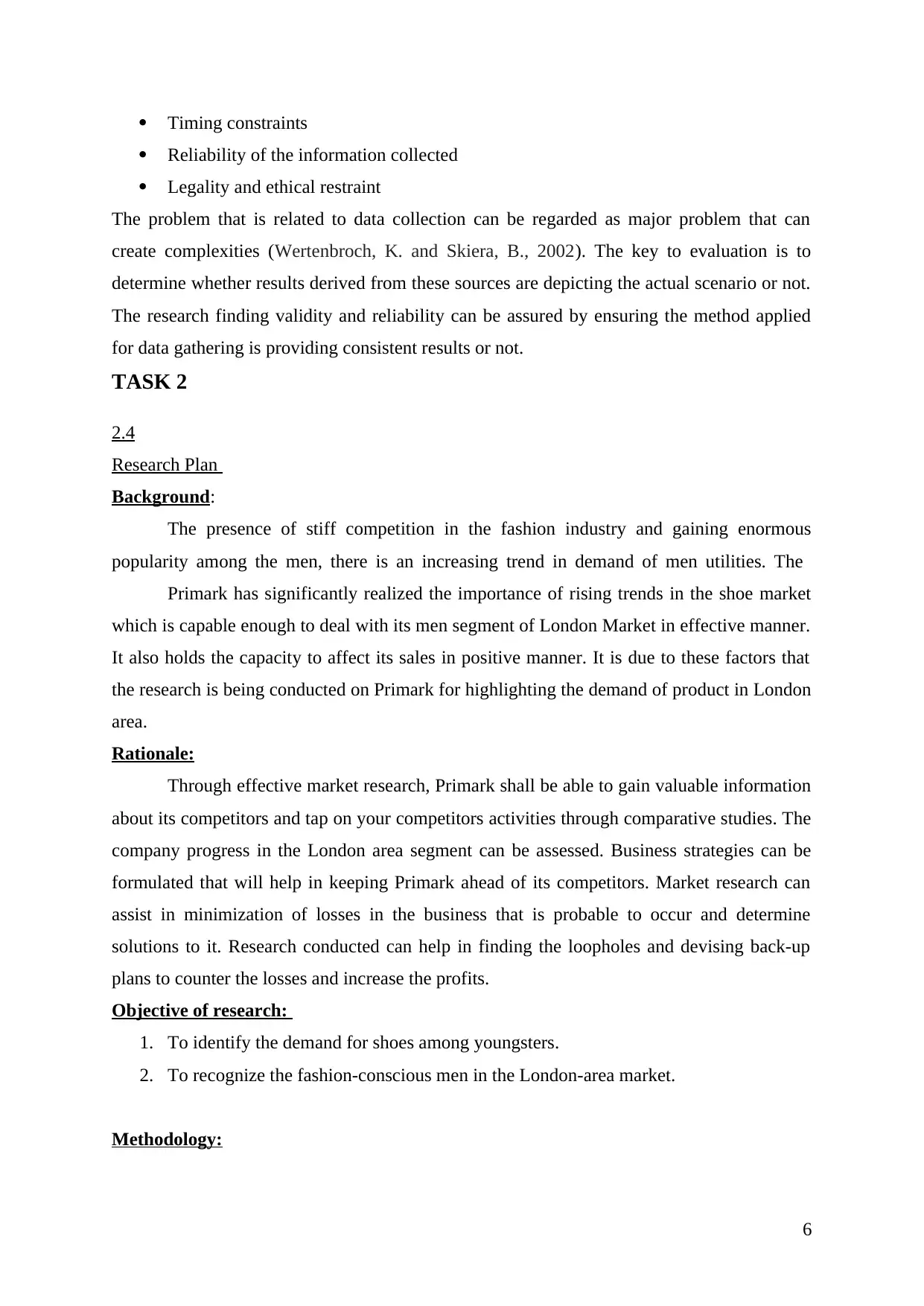
Timing constraints
Reliability of the information collected
Legality and ethical restraint
The problem that is related to data collection can be regarded as major problem that can
create complexities (Wertenbroch, K. and Skiera, B., 2002). The key to evaluation is to
determine whether results derived from these sources are depicting the actual scenario or not.
The research finding validity and reliability can be assured by ensuring the method applied
for data gathering is providing consistent results or not.
TASK 2
2.4
Research Plan
Background:
The presence of stiff competition in the fashion industry and gaining enormous
popularity among the men, there is an increasing trend in demand of men utilities. The
Primark has significantly realized the importance of rising trends in the shoe market
which is capable enough to deal with its men segment of London Market in effective manner.
It also holds the capacity to affect its sales in positive manner. It is due to these factors that
the research is being conducted on Primark for highlighting the demand of product in London
area.
Rationale:
Through effective market research, Primark shall be able to gain valuable information
about its competitors and tap on your competitors activities through comparative studies. The
company progress in the London area segment can be assessed. Business strategies can be
formulated that will help in keeping Primark ahead of its competitors. Market research can
assist in minimization of losses in the business that is probable to occur and determine
solutions to it. Research conducted can help in finding the loopholes and devising back-up
plans to counter the losses and increase the profits.
Objective of research:
1. To identify the demand for shoes among youngsters.
2. To recognize the fashion-conscious men in the London-area market.
Methodology:
6
Reliability of the information collected
Legality and ethical restraint
The problem that is related to data collection can be regarded as major problem that can
create complexities (Wertenbroch, K. and Skiera, B., 2002). The key to evaluation is to
determine whether results derived from these sources are depicting the actual scenario or not.
The research finding validity and reliability can be assured by ensuring the method applied
for data gathering is providing consistent results or not.
TASK 2
2.4
Research Plan
Background:
The presence of stiff competition in the fashion industry and gaining enormous
popularity among the men, there is an increasing trend in demand of men utilities. The
Primark has significantly realized the importance of rising trends in the shoe market
which is capable enough to deal with its men segment of London Market in effective manner.
It also holds the capacity to affect its sales in positive manner. It is due to these factors that
the research is being conducted on Primark for highlighting the demand of product in London
area.
Rationale:
Through effective market research, Primark shall be able to gain valuable information
about its competitors and tap on your competitors activities through comparative studies. The
company progress in the London area segment can be assessed. Business strategies can be
formulated that will help in keeping Primark ahead of its competitors. Market research can
assist in minimization of losses in the business that is probable to occur and determine
solutions to it. Research conducted can help in finding the loopholes and devising back-up
plans to counter the losses and increase the profits.
Objective of research:
1. To identify the demand for shoes among youngsters.
2. To recognize the fashion-conscious men in the London-area market.
Methodology:
6
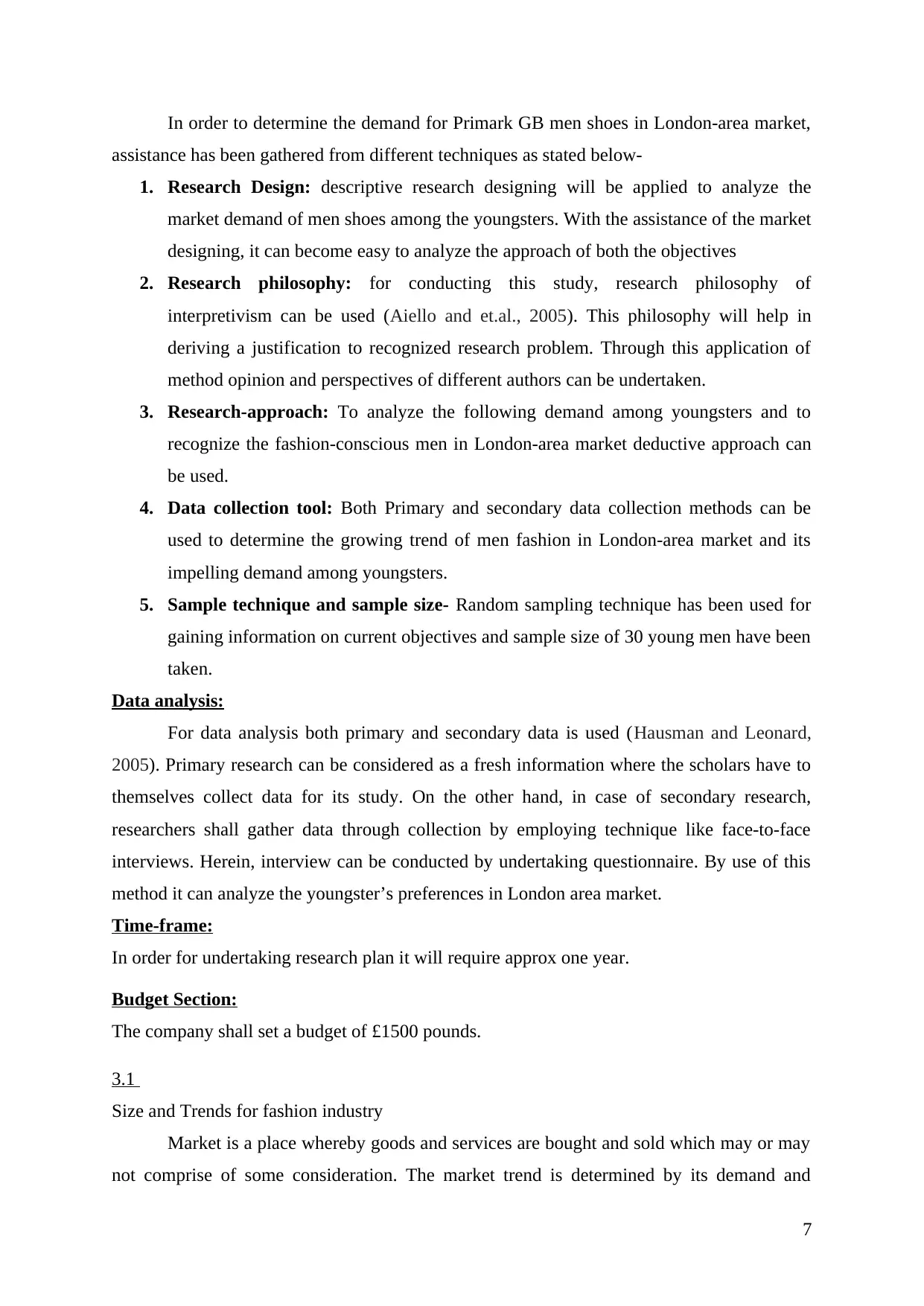
In order to determine the demand for Primark GB men shoes in London-area market,
assistance has been gathered from different techniques as stated below-
1. Research Design: descriptive research designing will be applied to analyze the
market demand of men shoes among the youngsters. With the assistance of the market
designing, it can become easy to analyze the approach of both the objectives
2. Research philosophy: for conducting this study, research philosophy of
interpretivism can be used (Aiello and et.al., 2005). This philosophy will help in
deriving a justification to recognized research problem. Through this application of
method opinion and perspectives of different authors can be undertaken.
3. Research-approach: To analyze the following demand among youngsters and to
recognize the fashion-conscious men in London-area market deductive approach can
be used.
4. Data collection tool: Both Primary and secondary data collection methods can be
used to determine the growing trend of men fashion in London-area market and its
impelling demand among youngsters.
5. Sample technique and sample size- Random sampling technique has been used for
gaining information on current objectives and sample size of 30 young men have been
taken.
Data analysis:
For data analysis both primary and secondary data is used (Hausman and Leonard,
2005). Primary research can be considered as a fresh information where the scholars have to
themselves collect data for its study. On the other hand, in case of secondary research,
researchers shall gather data through collection by employing technique like face-to-face
interviews. Herein, interview can be conducted by undertaking questionnaire. By use of this
method it can analyze the youngster’s preferences in London area market.
Time-frame:
In order for undertaking research plan it will require approx one year.
Budget Section:
The company shall set a budget of £1500 pounds.
3.1
Size and Trends for fashion industry
Market is a place whereby goods and services are bought and sold which may or may
not comprise of some consideration. The market trend is determined by its demand and
7
assistance has been gathered from different techniques as stated below-
1. Research Design: descriptive research designing will be applied to analyze the
market demand of men shoes among the youngsters. With the assistance of the market
designing, it can become easy to analyze the approach of both the objectives
2. Research philosophy: for conducting this study, research philosophy of
interpretivism can be used (Aiello and et.al., 2005). This philosophy will help in
deriving a justification to recognized research problem. Through this application of
method opinion and perspectives of different authors can be undertaken.
3. Research-approach: To analyze the following demand among youngsters and to
recognize the fashion-conscious men in London-area market deductive approach can
be used.
4. Data collection tool: Both Primary and secondary data collection methods can be
used to determine the growing trend of men fashion in London-area market and its
impelling demand among youngsters.
5. Sample technique and sample size- Random sampling technique has been used for
gaining information on current objectives and sample size of 30 young men have been
taken.
Data analysis:
For data analysis both primary and secondary data is used (Hausman and Leonard,
2005). Primary research can be considered as a fresh information where the scholars have to
themselves collect data for its study. On the other hand, in case of secondary research,
researchers shall gather data through collection by employing technique like face-to-face
interviews. Herein, interview can be conducted by undertaking questionnaire. By use of this
method it can analyze the youngster’s preferences in London area market.
Time-frame:
In order for undertaking research plan it will require approx one year.
Budget Section:
The company shall set a budget of £1500 pounds.
3.1
Size and Trends for fashion industry
Market is a place whereby goods and services are bought and sold which may or may
not comprise of some consideration. The market trend is determined by its demand and
7
⊘ This is a preview!⊘
Do you want full access?
Subscribe today to unlock all pages.

Trusted by 1+ million students worldwide
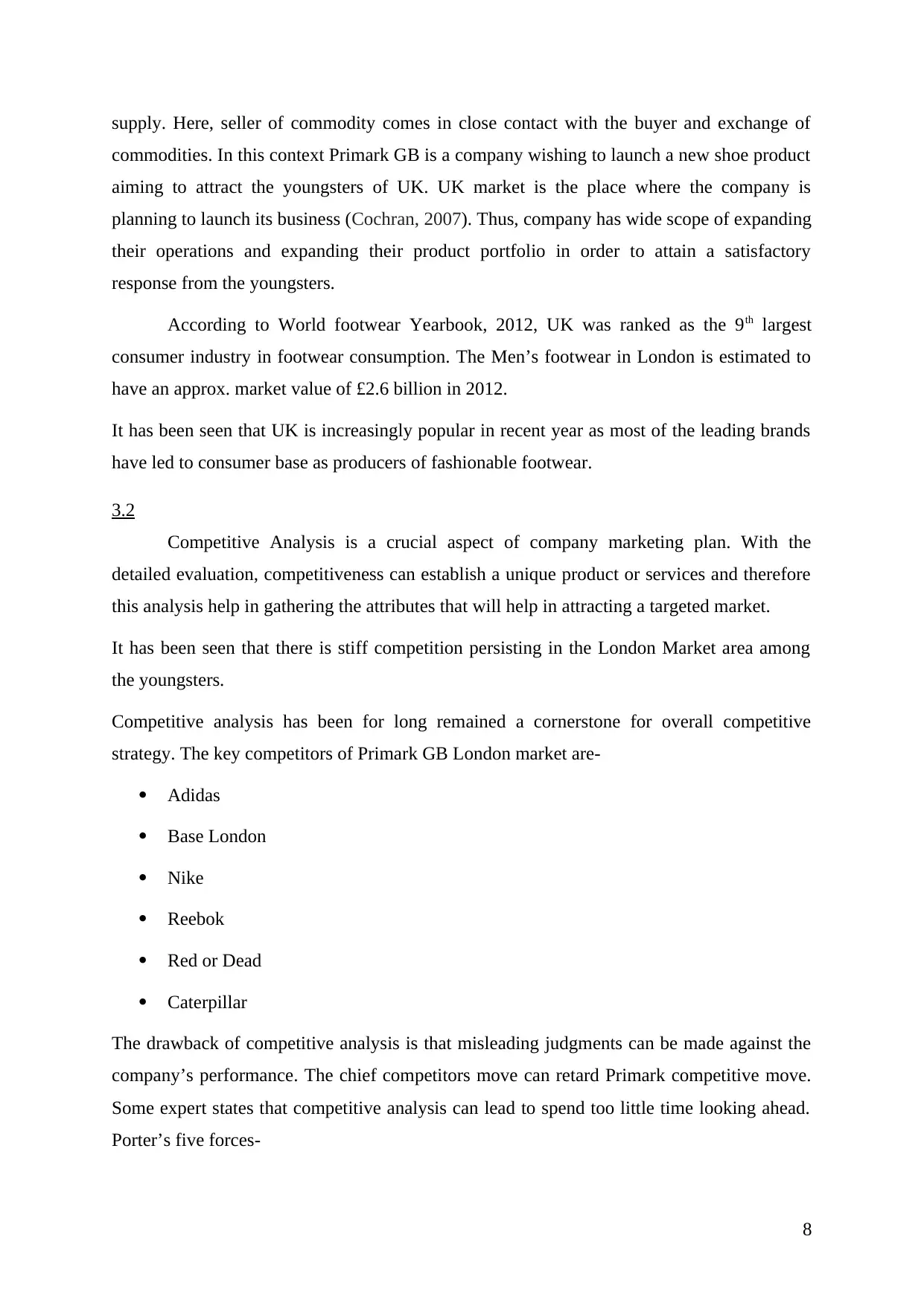
supply. Here, seller of commodity comes in close contact with the buyer and exchange of
commodities. In this context Primark GB is a company wishing to launch a new shoe product
aiming to attract the youngsters of UK. UK market is the place where the company is
planning to launch its business (Cochran, 2007). Thus, company has wide scope of expanding
their operations and expanding their product portfolio in order to attain a satisfactory
response from the youngsters.
According to World footwear Yearbook, 2012, UK was ranked as the 9th largest
consumer industry in footwear consumption. The Men’s footwear in London is estimated to
have an approx. market value of £2.6 billion in 2012.
It has been seen that UK is increasingly popular in recent year as most of the leading brands
have led to consumer base as producers of fashionable footwear.
3.2
Competitive Analysis is a crucial aspect of company marketing plan. With the
detailed evaluation, competitiveness can establish a unique product or services and therefore
this analysis help in gathering the attributes that will help in attracting a targeted market.
It has been seen that there is stiff competition persisting in the London Market area among
the youngsters.
Competitive analysis has been for long remained a cornerstone for overall competitive
strategy. The key competitors of Primark GB London market are-
Adidas
Base London
Nike
Reebok
Red or Dead
Caterpillar
The drawback of competitive analysis is that misleading judgments can be made against the
company’s performance. The chief competitors move can retard Primark competitive move.
Some expert states that competitive analysis can lead to spend too little time looking ahead.
Porter’s five forces-
8
commodities. In this context Primark GB is a company wishing to launch a new shoe product
aiming to attract the youngsters of UK. UK market is the place where the company is
planning to launch its business (Cochran, 2007). Thus, company has wide scope of expanding
their operations and expanding their product portfolio in order to attain a satisfactory
response from the youngsters.
According to World footwear Yearbook, 2012, UK was ranked as the 9th largest
consumer industry in footwear consumption. The Men’s footwear in London is estimated to
have an approx. market value of £2.6 billion in 2012.
It has been seen that UK is increasingly popular in recent year as most of the leading brands
have led to consumer base as producers of fashionable footwear.
3.2
Competitive Analysis is a crucial aspect of company marketing plan. With the
detailed evaluation, competitiveness can establish a unique product or services and therefore
this analysis help in gathering the attributes that will help in attracting a targeted market.
It has been seen that there is stiff competition persisting in the London Market area among
the youngsters.
Competitive analysis has been for long remained a cornerstone for overall competitive
strategy. The key competitors of Primark GB London market are-
Adidas
Base London
Nike
Reebok
Red or Dead
Caterpillar
The drawback of competitive analysis is that misleading judgments can be made against the
company’s performance. The chief competitors move can retard Primark competitive move.
Some expert states that competitive analysis can lead to spend too little time looking ahead.
Porter’s five forces-
8
Paraphrase This Document
Need a fresh take? Get an instant paraphrase of this document with our AI Paraphraser
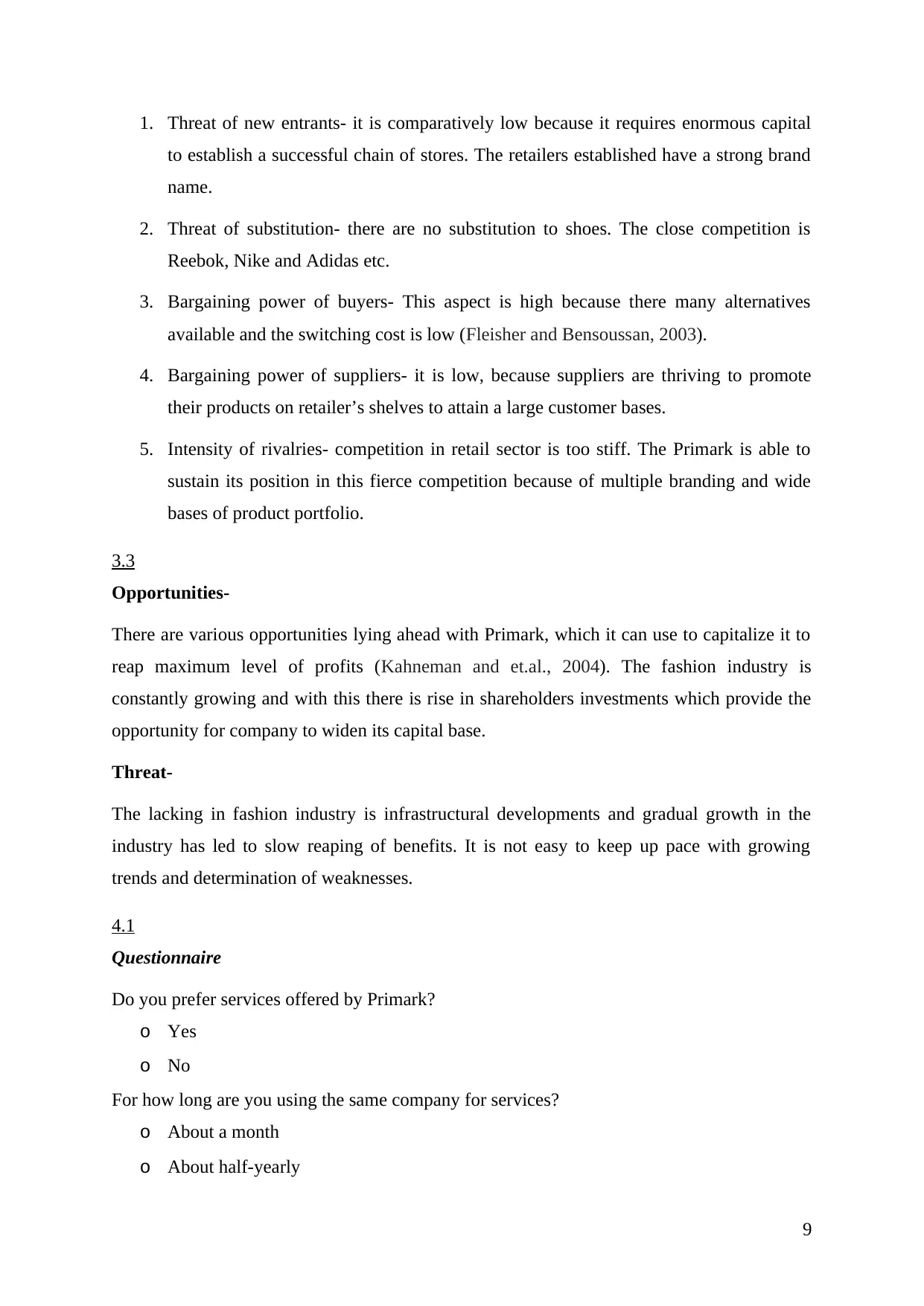
1. Threat of new entrants- it is comparatively low because it requires enormous capital
to establish a successful chain of stores. The retailers established have a strong brand
name.
2. Threat of substitution- there are no substitution to shoes. The close competition is
Reebok, Nike and Adidas etc.
3. Bargaining power of buyers- This aspect is high because there many alternatives
available and the switching cost is low (Fleisher and Bensoussan, 2003).
4. Bargaining power of suppliers- it is low, because suppliers are thriving to promote
their products on retailer’s shelves to attain a large customer bases.
5. Intensity of rivalries- competition in retail sector is too stiff. The Primark is able to
sustain its position in this fierce competition because of multiple branding and wide
bases of product portfolio.
3.3
Opportunities-
There are various opportunities lying ahead with Primark, which it can use to capitalize it to
reap maximum level of profits (Kahneman and et.al., 2004). The fashion industry is
constantly growing and with this there is rise in shareholders investments which provide the
opportunity for company to widen its capital base.
Threat-
The lacking in fashion industry is infrastructural developments and gradual growth in the
industry has led to slow reaping of benefits. It is not easy to keep up pace with growing
trends and determination of weaknesses.
4.1
Questionnaire
Do you prefer services offered by Primark?
o Yes
o No
For how long are you using the same company for services?
o About a month
o About half-yearly
9
to establish a successful chain of stores. The retailers established have a strong brand
name.
2. Threat of substitution- there are no substitution to shoes. The close competition is
Reebok, Nike and Adidas etc.
3. Bargaining power of buyers- This aspect is high because there many alternatives
available and the switching cost is low (Fleisher and Bensoussan, 2003).
4. Bargaining power of suppliers- it is low, because suppliers are thriving to promote
their products on retailer’s shelves to attain a large customer bases.
5. Intensity of rivalries- competition in retail sector is too stiff. The Primark is able to
sustain its position in this fierce competition because of multiple branding and wide
bases of product portfolio.
3.3
Opportunities-
There are various opportunities lying ahead with Primark, which it can use to capitalize it to
reap maximum level of profits (Kahneman and et.al., 2004). The fashion industry is
constantly growing and with this there is rise in shareholders investments which provide the
opportunity for company to widen its capital base.
Threat-
The lacking in fashion industry is infrastructural developments and gradual growth in the
industry has led to slow reaping of benefits. It is not easy to keep up pace with growing
trends and determination of weaknesses.
4.1
Questionnaire
Do you prefer services offered by Primark?
o Yes
o No
For how long are you using the same company for services?
o About a month
o About half-yearly
9
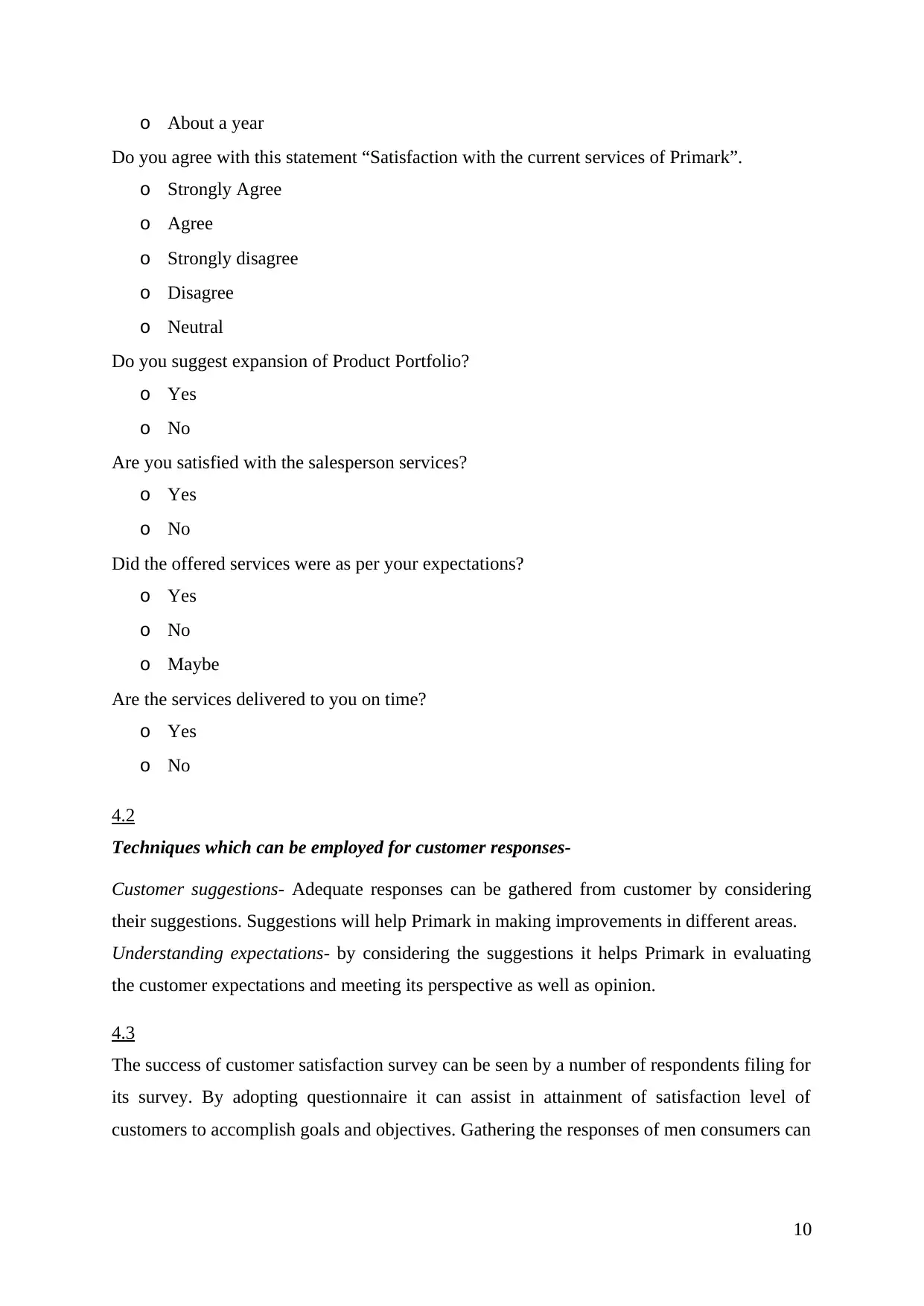
o About a year
Do you agree with this statement “Satisfaction with the current services of Primark”.
o Strongly Agree
o Agree
o Strongly disagree
o Disagree
o Neutral
Do you suggest expansion of Product Portfolio?
o Yes
o No
Are you satisfied with the salesperson services?
o Yes
o No
Did the offered services were as per your expectations?
o Yes
o No
o Maybe
Are the services delivered to you on time?
o Yes
o No
4.2
Techniques which can be employed for customer responses-
Customer suggestions- Adequate responses can be gathered from customer by considering
their suggestions. Suggestions will help Primark in making improvements in different areas.
Understanding expectations- by considering the suggestions it helps Primark in evaluating
the customer expectations and meeting its perspective as well as opinion.
4.3
The success of customer satisfaction survey can be seen by a number of respondents filing for
its survey. By adopting questionnaire it can assist in attainment of satisfaction level of
customers to accomplish goals and objectives. Gathering the responses of men consumers can
10
Do you agree with this statement “Satisfaction with the current services of Primark”.
o Strongly Agree
o Agree
o Strongly disagree
o Disagree
o Neutral
Do you suggest expansion of Product Portfolio?
o Yes
o No
Are you satisfied with the salesperson services?
o Yes
o No
Did the offered services were as per your expectations?
o Yes
o No
o Maybe
Are the services delivered to you on time?
o Yes
o No
4.2
Techniques which can be employed for customer responses-
Customer suggestions- Adequate responses can be gathered from customer by considering
their suggestions. Suggestions will help Primark in making improvements in different areas.
Understanding expectations- by considering the suggestions it helps Primark in evaluating
the customer expectations and meeting its perspective as well as opinion.
4.3
The success of customer satisfaction survey can be seen by a number of respondents filing for
its survey. By adopting questionnaire it can assist in attainment of satisfaction level of
customers to accomplish goals and objectives. Gathering the responses of men consumers can
10
⊘ This is a preview!⊘
Do you want full access?
Subscribe today to unlock all pages.

Trusted by 1+ million students worldwide
1 out of 16
Related Documents
Your All-in-One AI-Powered Toolkit for Academic Success.
+13062052269
info@desklib.com
Available 24*7 on WhatsApp / Email
![[object Object]](/_next/static/media/star-bottom.7253800d.svg)
Unlock your academic potential
Copyright © 2020–2025 A2Z Services. All Rights Reserved. Developed and managed by ZUCOL.





